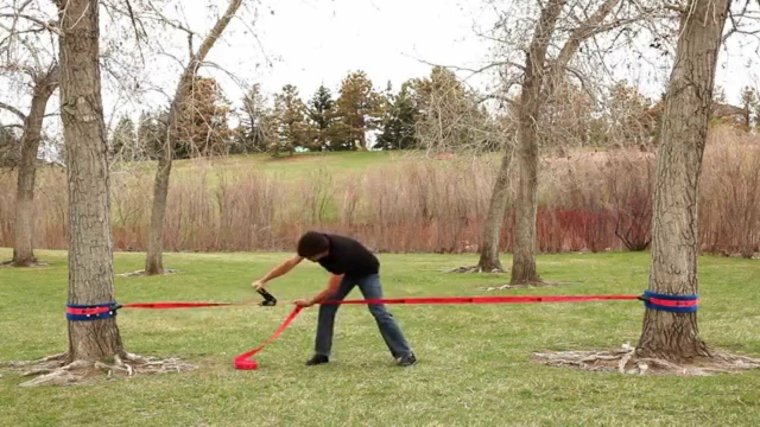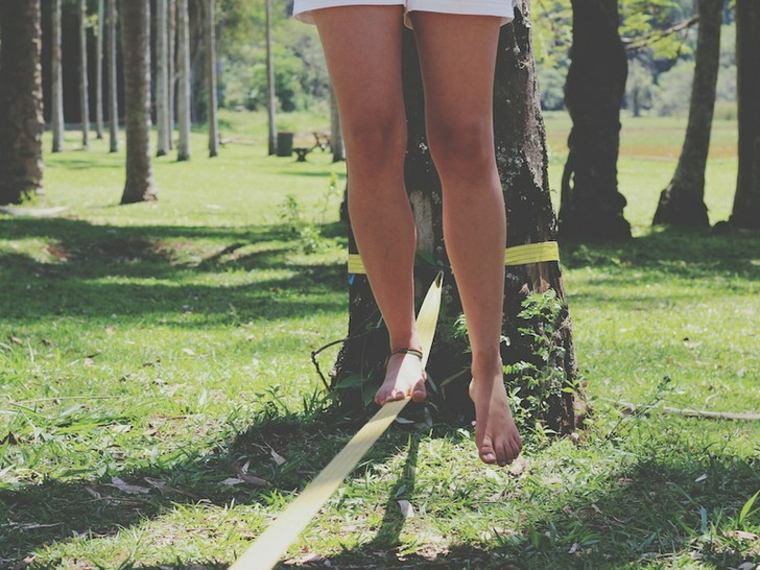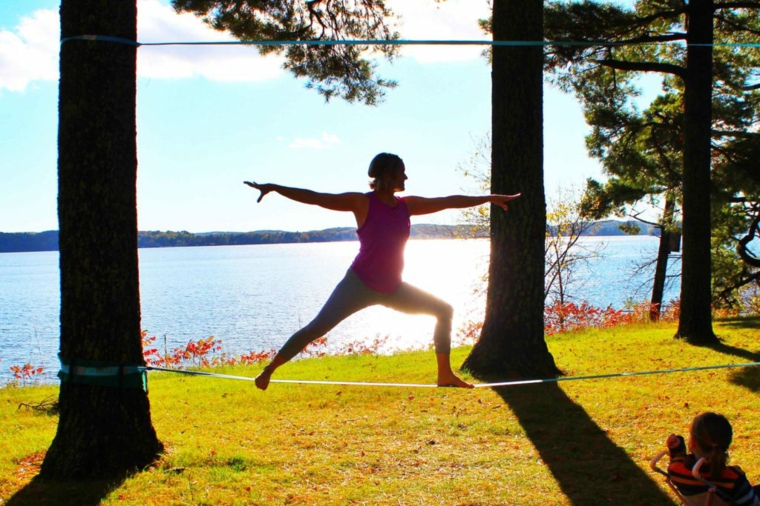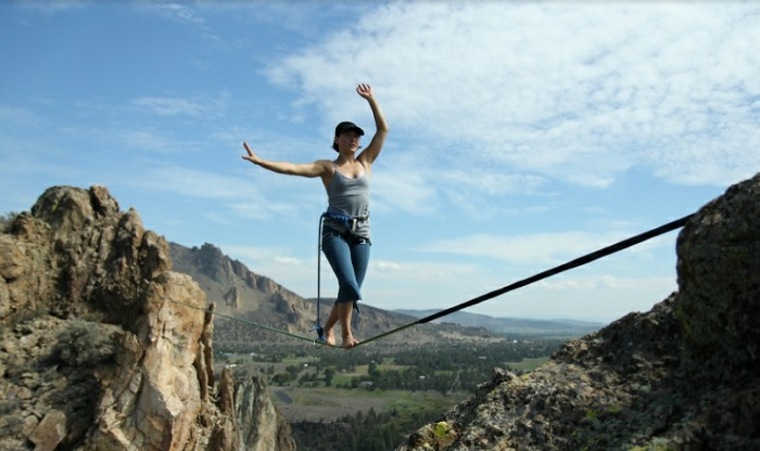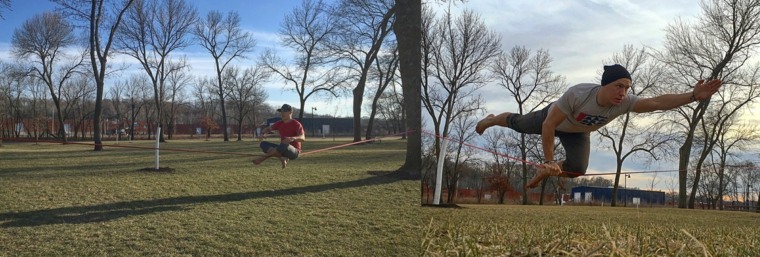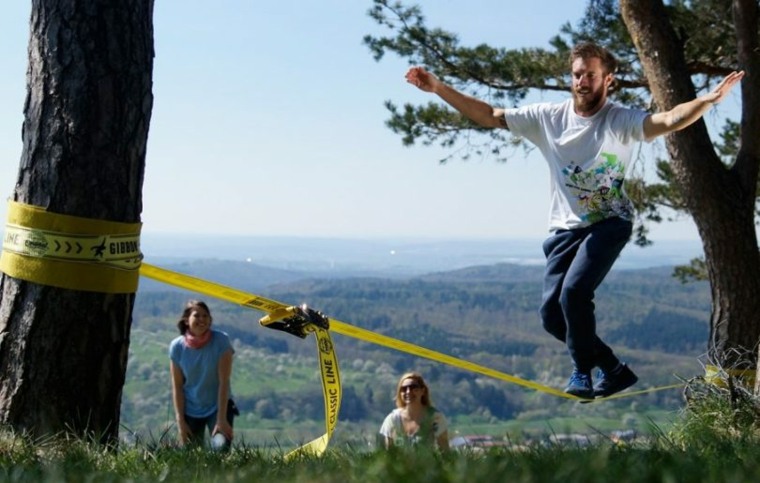Equilibrio caminando sobre una cinta – ¿qué es el slackline?
Equilibrio caminando sobre una cinta – ¿qué es el slackline?
El slackline, también conocido como cuerda floja, es una disciplina que se ha vuelto muy popular en los últimos años. Consiste en caminar y realizar acrobacias sobre una cinta estrecha y flexible, similar a una cuerda de escalada, tensada entre dos puntos fijos, como árboles o postes.
Esta actividad nació en la década de 1970 en Yosemite, California, como una forma de entrenamiento para escaladores. Sin embargo, pronto se convirtió en una disciplina independiente, con numerosos seguidores y competiciones en todo el mundo.
El slackline requiere un increíble equilibrio, concentración y fuerza tanto física como mental. Aunque en apariencia parece fácil, caminar sobre una cinta tensada es un desafío que requiere práctica y perseverancia. El slackliner debe mantener el equilibrio mientras atraviesa la cinta, utilizando la tensión de ésta para mantenerse estable. Cada paso debe ser cauteloso y preciso, ya que el más mínimo movimiento puede hacer que la cinta oscile y provoque una caída.
Además de caminar, los slackliners pueden realizar una serie de acrobacias y trucos sobre la cinta. Esto incluye saltos, giros, equilibrios estáticos y hasta saltos mortales. Algunos incluso practican la disciplina a gran altura, como en acantilados o rascacielos, lo que añade un nivel aún mayor de dificultad y riesgo.
El slackline es más que una simple actividad física, es también una forma de meditación en movimiento. Al concentrarse en el equilibrio y en cada paso sobre la cinta, el slackliner deja de lado las preocupaciones y el estrés de la vida cotidiana, centrándose únicamente en el presente. Esta conexión mente-cuerpo es uno de los aspectos más gratificantes de esta disciplina.
En la actualidad, el slackline ha ganado reconocimiento como un deporte legítimo. Se celebran competiciones y eventos internacionales, donde los mejores slackliners del mundo demuestran sus habilidades y creatividad. Además, esta disciplina ha sido adoptada por algunos deportes extremos como el surf, el snowboard e incluso el parkour, en los que el equilibrio y la estabilidad son fundamentales.
En resumen, el slackline es una disciplina que desafía al equilibrio y la concentración, brindando a quienes la practican una experiencia única y gratificante. Ya sea como un deporte competitivo o como una forma de relajación y conexión con uno mismo, el slackline continúa creciendo en popularidad y atrayendo a personas de todas las edades y niveles de habilidad. El slackline es una disciplina que consiste en caminar y realizar acrobacias sobre una cinta estrecha y flexible llamada slackline. Esta cinta se tensa entre dos puntos fijos, como árboles o postes, y el slackliner debe mantener el equilibrio mientras atraviesa la cinta.
Esta actividad nació en la década de 1970 en Yosemite, California, como una forma de entrenamiento para escaladores. Sin embargo, pronto se convirtió en una disciplina independiente, con numerosos seguidores y competiciones en todo el mundo.
El slackline requiere un increíble equilibrio, concentración y fuerza tanto física como mental. Aunque en apariencia parece fácil, caminar sobre una cinta tensada es un desafío que requiere práctica y perseverancia. El slackliner debe mantener el equilibrio utilizando la tensión de la cinta, y cada paso debe ser cauteloso y preciso.
Además de caminar, los slackliners pueden realizar una serie de acrobacias y trucos sobre la cinta, como saltos, giros y equilibrios estáticos. Algunos incluso practican la disciplina a gran altura, lo que añade un nivel aún mayor de dificultad y riesgo.
El slackline no solo es una actividad física, también es una forma de meditación en movimiento. Al concentrarse en el equilibrio y en cada paso sobre la cinta, el slackliner puede dejar de lado las preocupaciones y el estrés de la vida cotidiana, centrándose únicamente en el presente.
En la actualidad, el slackline se considera un deporte legítimo y se celebran competiciones y eventos internacionales donde los mejores slackliners del mundo demuestran sus habilidades. Además, esta disciplina ha sido adoptada por otros deportes extremos donde el equilibrio y la estabilidad son fundamentales.
En resumen, el slackline es una disciplina que desafía el equilibrio y la concentración, brindando una experiencia única y gratificante a quienes la practican. Ya sea como un deporte competitivo o como una forma de relajación y conexión con uno mismo, el slackline continúa creciendo en popularidad y atrayendo a personas de todas las edades y niveles de habilidad. El slackline es una disciplina que consiste en caminar y realizar acrobacias sobre una cinta estrecha y flexible llamada slackline. Esta cinta se tensa entre dos puntos fijos, como árboles o postes, y el slackliner debe mantener el equilibrio mientras atraviesa la cinta.
Esta actividad se originó en la década de 1970 en Yosemite, California, como una forma de entrenamiento para escaladores, pero luego se volvió una disciplina independiente con seguidores y competiciones en todo el mundo.
El slackline requiere un equilibrio, concentración y fuerza física y mental increíbles. Aunque puede parecer fácil, caminar sobre una cinta tensada es un desafío que requiere práctica y perseverancia. El slackliner debe mantener el equilibrio utilizando la tensión de la cinta, y cada paso debe ser cauteloso y preciso para evitar que la cinta oscile y provoque una caída.
Además de caminar, los slackliners pueden realizar acrobacias y trucos, como saltos, giros y equilibrios estáticos, sobre la cinta. Algunos incluso practican a gran altura, lo que aumenta la dificultad y el riesgo.
El slackline no solo es una actividad física, también es una forma de meditación en movimiento. Al concentrarse en el equilibrio y en cada paso sobre la cinta, el slackliner puede desconectarse del estrés y las preocupaciones de la vida diaria y enfocarse en el presente.
En la actualidad, el slackline se considera un deporte legítimo y se celebran competiciones y eventos internacionales donde los mejores slackliners del mundo demuestran sus habilidades. Además, esta disciplina ha sido adoptada por otros deportes extremos donde el equilibrio y la estabilidad son fundamentales.
En resumen, el slackline desafía el equilibrio y la concentración, ofreciendo una experiencia única y gratificante para quienes lo practican. Ya sea como deporte competitivo o como forma de relajación y conexión con uno mismo, el slackline continúa ganando popularidad y atrayendo a personas de todas las edades y niveles de habilidad. El slackline es una disciplina que consiste en caminar y realizar acrobacias sobre una cinta estrecha y flexible llamada slackline. Esta cinta se tensa entre dos puntos fijos, como árboles o postes, y el slackliner debe mantener el equilibrio mientras atraviesa la cinta.
Esta actividad se originó en la década de 1970 en Yosemite, California, como una forma de entrenamiento para escaladores, pero luego se volvió una disciplina independiente con seguidores y competiciones en todo el mundo.
El slackline requiere un equilibrio, concentración y fuerza física y mental increíbles. Aunque puede parecer fácil, caminar sobre una cinta tensada es un desafío que requiere práctica y perseverancia. El slackliner debe mantener el equilibrio utilizando la tensión de la cinta, y cada paso debe ser cauteloso y preciso para evitar que la cinta oscile y provoque una caída.
Además de caminar, los slackliners pueden realizar acrobacias y trucos, como saltos, giros y equilibrios estáticos, sobre la cinta. Algunos incluso practican a gran altura, lo que aumenta la dificultad y el riesgo.
El slackline no solo es una actividad física, también es una forma de meditación en movimiento. Al concentrarse en el equilibrio y en cada paso sobre la cinta, el slackliner puede desconectarse del estrés y las preocupaciones de la vida diaria y enfocarse en el presente.
En la actualidad, el slackline se considera un deporte legítimo y se celebran competiciones y eventos internacionales donde los mejores slackliners del mundo demuestran sus habilidades. Además, esta disciplina ha sido adoptada por otros deportes extremos donde el equilibrio y la estabilidad son fundamentales.
En resumen, el slackline desafía el equilibrio y la concentración, ofreciendo una experiencia única y gratificante para quienes lo practican. Ya sea como deporte competitivo o como forma de relajación y conexión con uno mismo, el slackline continúa ganando popularidad y atrayendo a personas de todas las edades y niveles de habilidad. El slackline es una disciplina que consiste en caminar y realizar acrobacias sobre una cinta estrecha y flexible llamada slackline. Esta cinta se tensa entre dos puntos fijos, como árboles o postes, y el slackliner debe mantener el equilibrio mientras atraviesa la cinta.
Esta actividad se originó en la década de 1970 en Yosemite, California, como una forma de entrenamiento para escaladores, pero luego se volvió una disciplina independiente con seguidores y competiciones en todo el mundo.
El slackline requiere un equilibrio, concentración y fuerza física y mental increíbles. Aunque puede parecer fácil, caminar sobre una cinta tensada es un desafío que requiere práctica y perseverancia. El slackliner debe mantener el equilibrio utilizando la tensión de la cinta, y cada paso debe ser cauteloso y preciso para evitar que la cinta oscile y provoque una caída.
Además de caminar, los slackliners pueden realizar acrobacias y trucos, como saltos, giros y equilibrios estáticos, sobre la cinta. Algunos incluso practican a gran altura, lo que aumenta la dificultad y el riesgo.
El slackline no solo es una actividad física, también es una forma de meditación en movimiento. Al concentrarse en el equilibrio y en cada paso sobre la cinta, el slackliner puede desconectarse del estrés y las preocupaciones de la vida diaria y enfocarse en el presente.
En la actualidad, el slackline se considera un deporte legítimo y se celebran competiciones y eventos internacionales donde los mejores slackliners del mundo demuestran sus habilidades. Además, esta disciplina ha sido adoptada por otros deportes extremos donde el equilibrio y la estabilidad son fundamentales.
En resumen, el slackline desafía el equilibrio y la concentración, ofreciendo una experiencia única y gratificante para quienes lo practican. Ya sea como deporte competitivo o como forma de relajación y conexión con uno mismo, el slackline continúa ganando popularidad y atrayendo a personas de todas las edades y niveles de habilidad.
Slacklining: The Art of Balance and Adventure
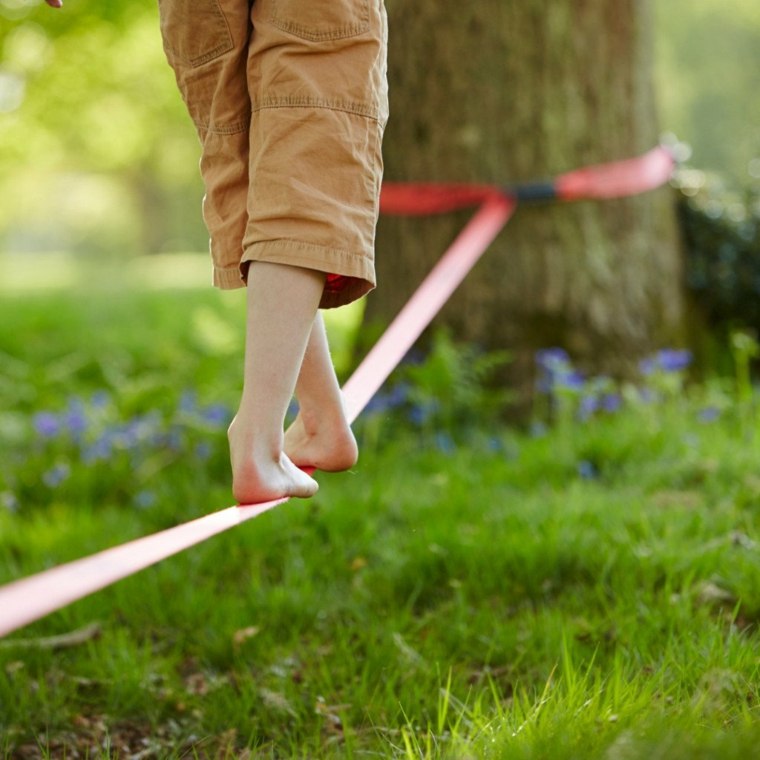
Have you ever heard of slacklining? It’s an incredible sport that involves maintaining balance on a 2.5 to 5 centimeter wide synthetic fiber line, stretched between fixed points (usually trees). But slacklining is so much more than just a sport. It’s a world of variations, disciplines, championships, and professional athletes.
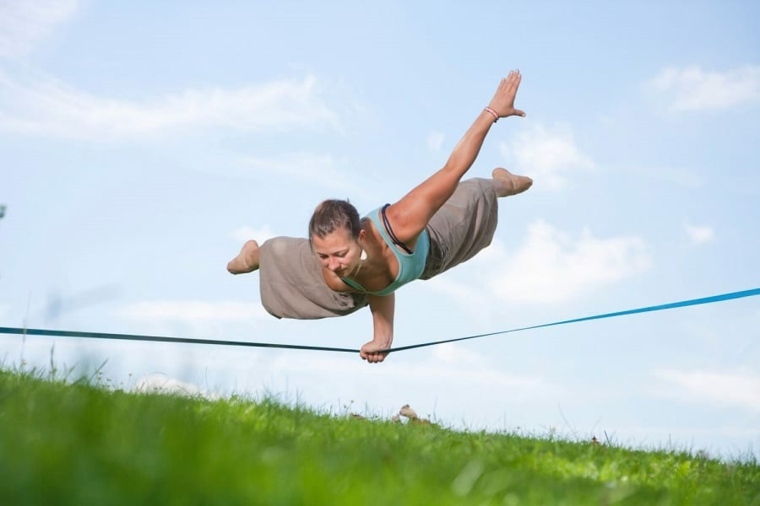
Slacklining is not only used as a training aid for balance in competitive sports like gymnastics or physiotherapy, but it also has creative aspects. It has a long tradition in shows and performances, and it’s even used to enhance public spaces. Moreover, it’s gaining popularity in school sports, tourism, and as a recreational activity during leisure time, thanks in part to the creation of slackline parks.
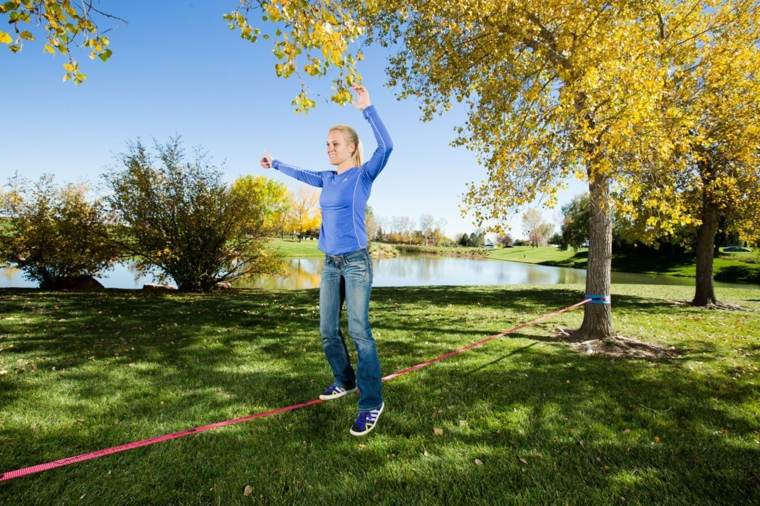
A slackline set consists of a piece of webbing (not a rope), two tree slings, and a tensioning system. If the slackline is set up between two trees, the set should also include tree protectors.
A Brief History
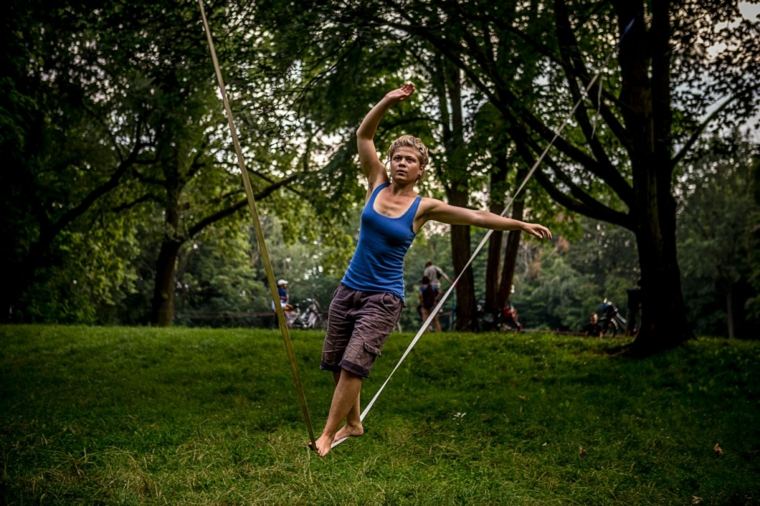
Throughout history, humans have always sought balance on various objects, such as cables, ropes, or rigid beams. Climbers, for example, would pass the time on rainy days or rest days by balancing on chain barriers in parking lots and other similar structures. Slacklining emerged as an independent activity within the elastic fabric of this leisurely pastime in the early 80s, among climbers in Yosemite National Park.
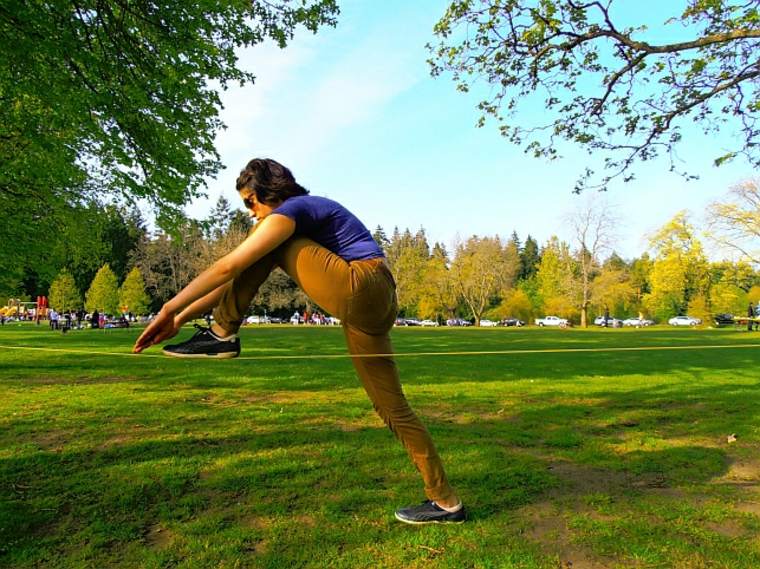
Adam Grosowsky and Jeff Ellington were the first to use their climbing gear to balance and introduced slacklining to climber camps in the valley. From there, it slowly spread to other countries within the climbing scene, eventually reaching Switzerland. However, the slackline trend really took off around 2006 in Europe with the introduction of simple slackline sets in sports stores. It is estimated that one in twenty people in Switzerland owns a slackline.
How is Slacklining Different from Tightrope Walking?
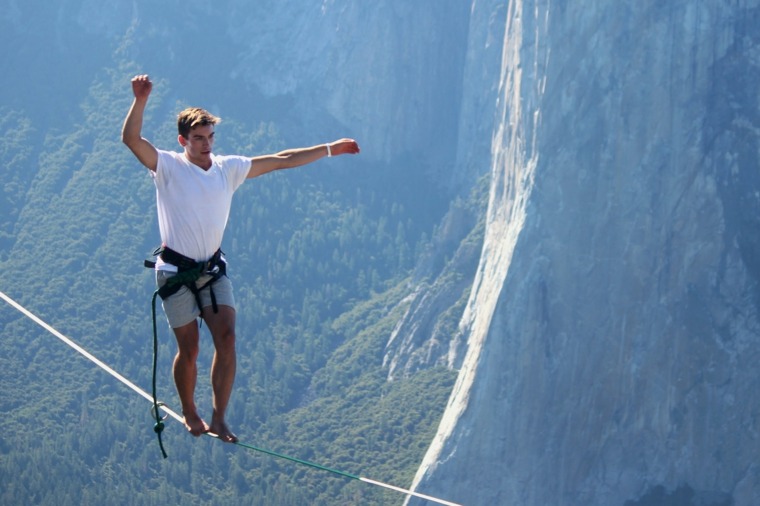
The name “Slackline” says it all – the line is not under much tension. Unlike steel cables, the synthetic webbing can stretch under the weight of the slackliner, making it dynamic. This constant movement on the line adds an extra challenge to walking on it.
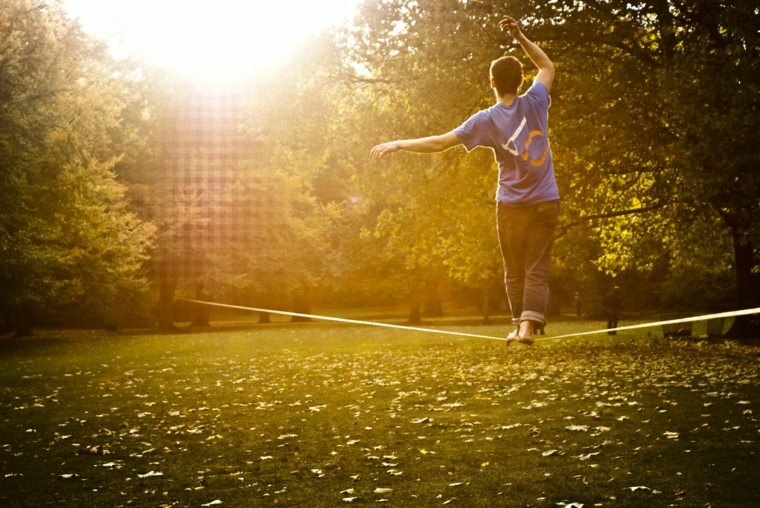
While tightrope walking has a long circus tradition, slacklining is a relatively young activity. In essence, all the tricks performed by tightrope artists on steel cables are also possible on a slackline. However, due to the elastic properties of the webbing, there are also a variety of dynamic tricks that can be performed on a slackline. Other differences include the fact that slacklines require very little effort to set up and this sport can easily be practiced barefoot.
Slacklining in Switzerland – Slackliners at the Bern City Slack Festival

Slackline sets were first marketed in Switzerland in 2006. The country has one of the highest concentrations of slackliners, along with Austria, Germany, and Brazil. Switzerland is home to nine slackline associations with a total of 350 members, as well as dozens of additional Facebook and Whatsapp groups. The oldest association is Slack Attack (Bern, 2009), while the youngest are the slackline associations in Vevey and Nyon (2016). All these associations are part of Swiss Slackline, the Swiss slackline federation. Swiss Slackline, in turn, is a founding member of the International Slackline Association (ISA), which was also founded in Switzerland in 2015. Thomas Buckingham, from central Switzerland, serves as the vice president of ISA and the president of Swiss Slackline. Festivals like the Bern City Slack Festival have become popular gathering places for slackliners from all over the world.
Switzerland has become famous in the world of slacklining, attracting more international athletes each year with events like the Bern City Slack, the Transalp Waterline Tour, and the Moléson Highline Meeting.
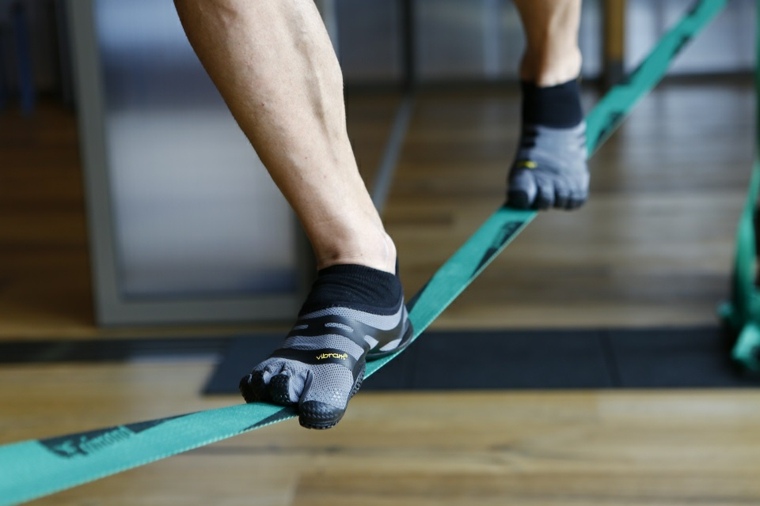
Although Switzerland is a small country with relatively few active slackliners, it has produced several world-famous athletes. Samuel Volery (born in 1989 in Uster) and Raphael Bacot (born in 1989 in Lausanne) continuously strive for world records in disciplines like highlining and longlining. Meanwhile, Leatizia Gonnon (born in 1991 in Geneva) holds the world records for women in the same disciplines and excels among male slackliners worldwide.
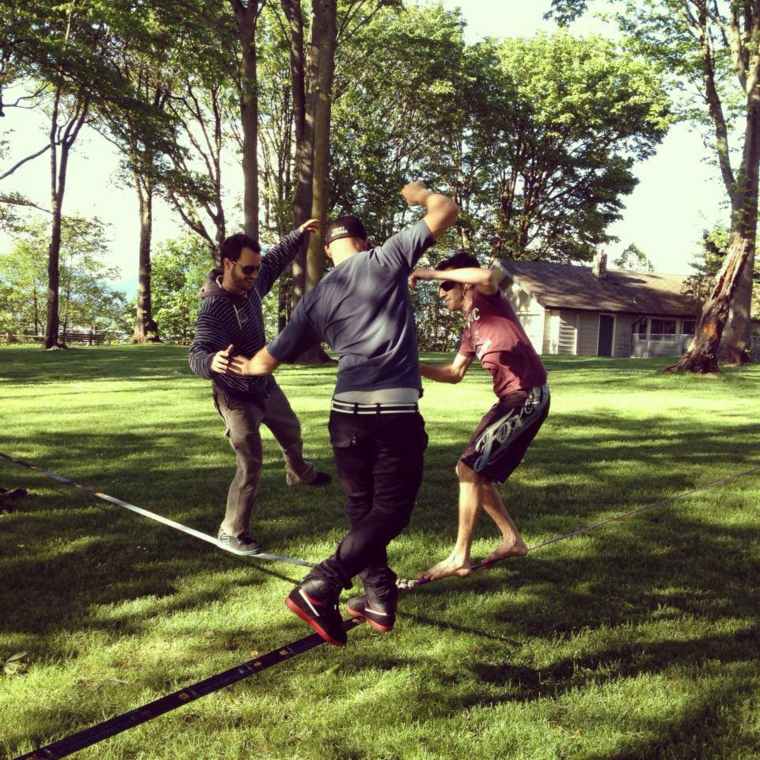
However, slacklining has faced negative press and intolerance in some circles.

Most people don’t slackline more than a few feet off the ground. It’s about balance and control, which satisfies many individuals. “It’s almost like meditation. When you’re slacklining, all you think about is the next step,” said Kate Vander Wiede, an engineering student at the University of Colorado. However, the university itself has a darker view of the sport. Citing safety concerns and potential tree damage, they have banned slacklining on campus this year after dozens of students started showing up with slacklines in campus courtyards.

Slackliners insist that the activity is no more dangerous than skateboarding or biking, and that properly secured slacklines, including padding, do not harm tree trunks.

“It’s a balance sport that uses taut nylon straps between two anchor points. Slacklining is different from tightrope walking in that the line is not held rigidly taut; instead, it is dynamic, stretching and bouncing like a long, narrow trampoline. The tension of the line can be adjusted to suit the user, and different types of dynamic webbing can be used to achieve a variety of feats. The line itself is flat, due to the nature of the webbing, thus preventing the base from swinging like it would with an ordinary rope. The dynamic nature of the line allows for impressive tricks and stunts.”

Tricklining or lowlining: This is the most common form, as it can be set up between two secure points and is low to the ground. A variety of tricks can be performed on the line, and since the sport is relatively new, there is plenty of room for innovation.

Highlining: This involves slacklining at great distances above the ground or water. When rigging high lines, experienced slackliners take measures to ensure solid, redundant, and equalized anchors to secure the line in place. To ensure safety, most highliners use a climbing harness or a Swami belt with a leash attached to the slackline; however, un-tethered walks on high lines are not unheard of.
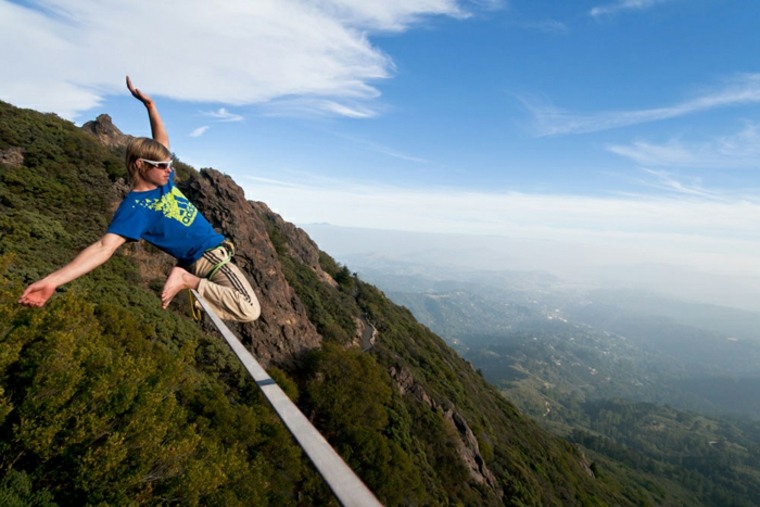
The longline slackline was primarily pioneered by Dean Potter, Larry Harpe, Ammon McNeely, and Braden Mayfield. Rumors of 200-300 feet slacklines were talked about, although there is no official record of line length from this period.
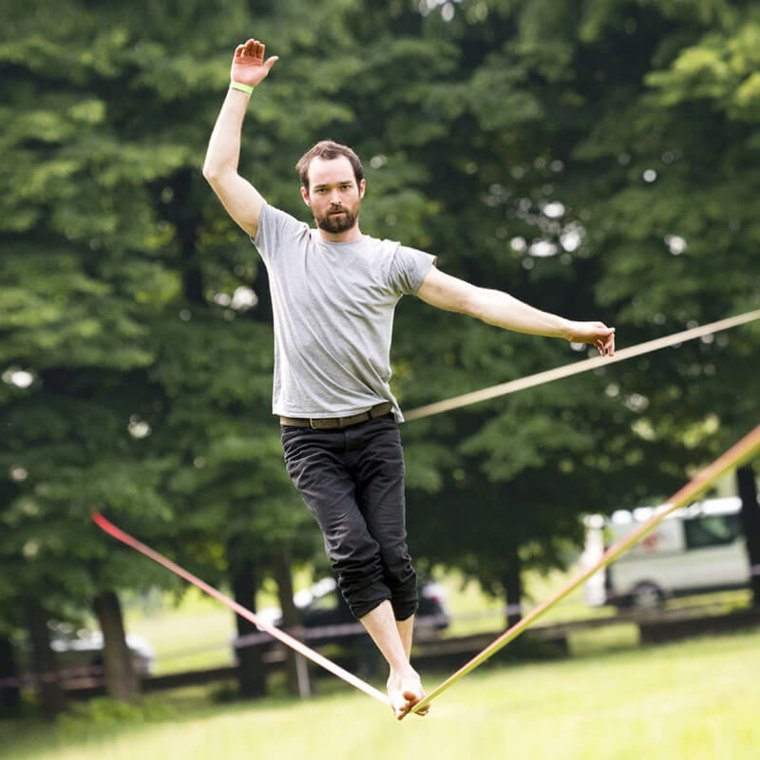
So, whether it’s tricklining or highlining, slacklining is an exciting sport that challenges balance and pushes the boundaries of what is possible. With its growing popularity, more athletes are discovering the thrill of slacklining in Switzerland and around the world.Slacklining: The Ultimate Guide to Finding Balance
Slacklining is the exhilarating sport of walking on a narrow, flat nylon rope between two points. Whether it’s in your backyard, on a college campus, or even 3000 feet above the ground, slacklining has become a worldwide phenomenon. People do it for fun, for the athletic benefits, and even for the meditative state of mind it can bring. It’s a common and popular pastime among outdoor enthusiasts.
But how exactly do you get started with slacklining? If you’re new to the sport, the idea of walking on a 1″ or 2″ line may seem intimidating. However, you don’t need to be a balance master to “walk the line.” With a little perseverance and patience, you’ll be swinging and swaying on a slackline in no time.
Setting up a slackline is the first step. It may seem obvious, but laying the rope low to the ground not only reduces the fear of falling, but also makes it easier to get on and off the line, which will happen frequently when you’re just starting out. For beginners, we recommend setting the line 1.5 to 2 feet off the ground for children and 2 to 2.5 feet for adults. Keep the line relatively short (around 10 to 20 feet) at these heights, as it will sag in the middle. Using a set of slackline supports will ensure the line is at the right height for beginners.
Once the line is set, it’s important to make sure it’s tightly secured. The tighter the slackline, the less wobbling and bouncing you’ll experience while walking. Experienced slackliners may prefer a looser line for tricks, surfing, and bouncing, but for beginners, all that extra movement can make it harder to stay upright. We recommend getting a beginner’s kit with a highly-rated ratchet system and a certified safety-tested line. This will give you the confidence to tighten the line as much as the ratchet allows. A stiffer line is almost like walking on a 2″ board.
If you’re having trouble getting the line tight enough, try this trick: have someone sit on the other side of the line from where you’re starting when you ratchet it. This will add extra tension and rigidity to the line, preventing it from swinging.
Now that the line is set and tight, it’s time to find your balance. Most people, even the most coordinated among us, can’t stay on the slackline for more than a few seconds when they first start. That’s why we recommend having a “helping hand” to give you a sense of walking on the line. Have a friend walk alongside you with their forearm out. You can hold onto their arm for balance or let go and grab on when you start to lose your footing.
With these tips in mind, you’re ready to embark on your slacklining journey. Remember, it may take some time and practice to find your balance, but the rewards are well worth it. So grab a slackline, head to your favorite park or backyard, and start walking the line. Adventure awaits!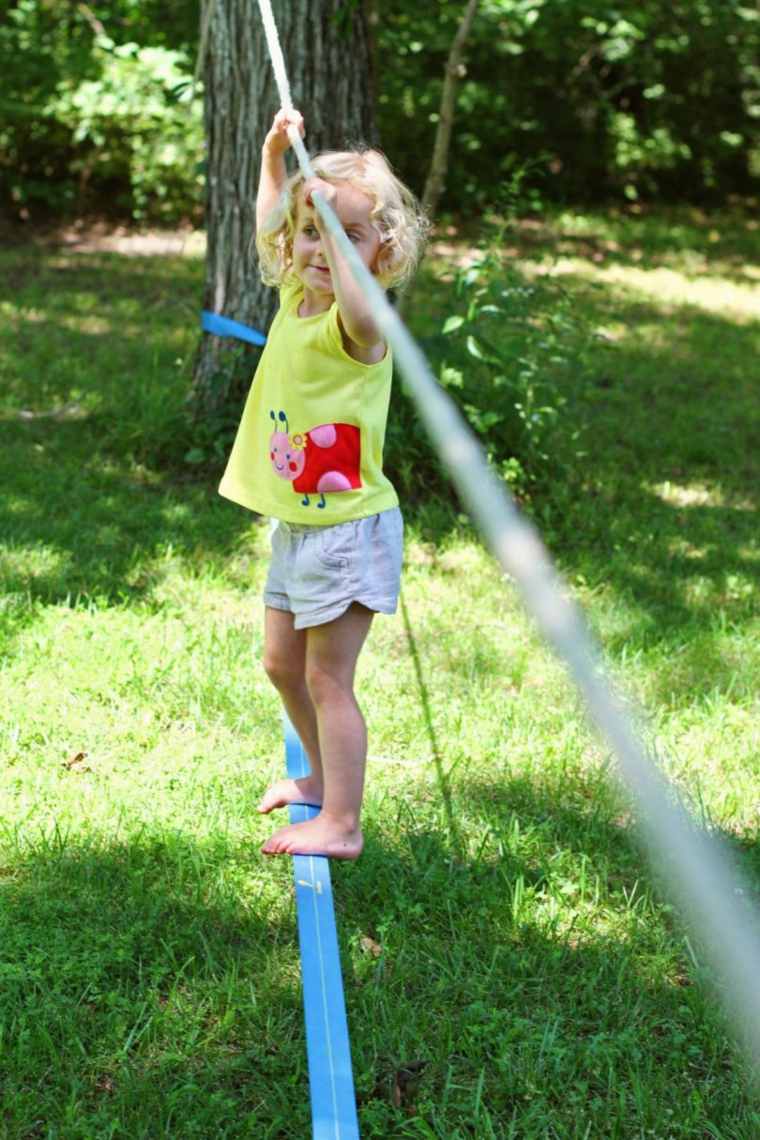
Hey there! Looking to try out slacklining but not sure where to start? Don’t worry, we’ve got you covered! Whether you have a partner or not, we’ve got some tips to help you get started on your slacklining journey.
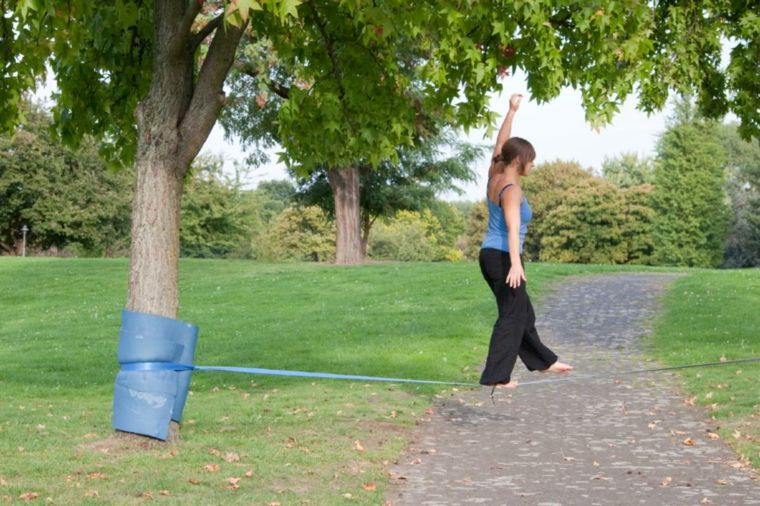
One of the best ways to get started is by using a slackline with a line of help. These lines can be set up above the slackline and give you something to hold onto as you walk along the line.
Building Muscle Memory

Now, here’s something funny that happens to most people when they first step onto a slackline… they start trembling. We’re not exactly sure why this happens, but it’s a common occurrence. The good news is that it usually goes away after a few sessions once you start building some muscle memory.
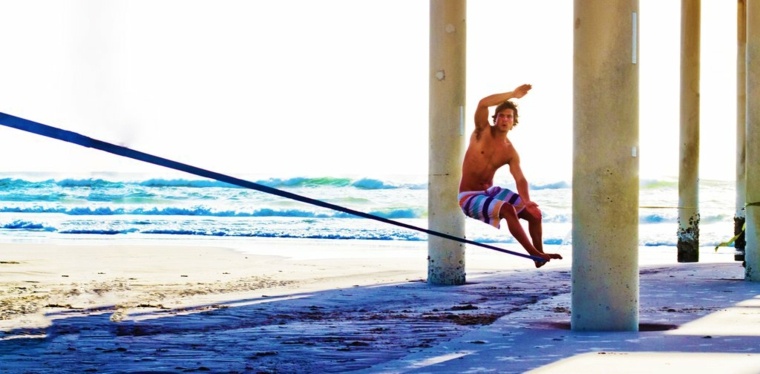
That’s why it’s important to get some help in the beginning. It allows you to quickly build familiarity and muscle memory on the line.
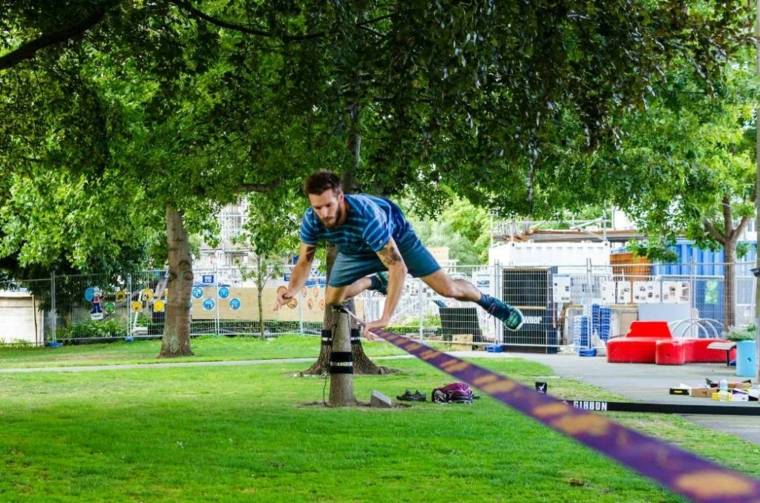
Just a heads up, if you’re over 16, be prepared for some sore core muscles after your first attempts. All those little flexor muscles in your core will be working overtime to help you maintain your balance!
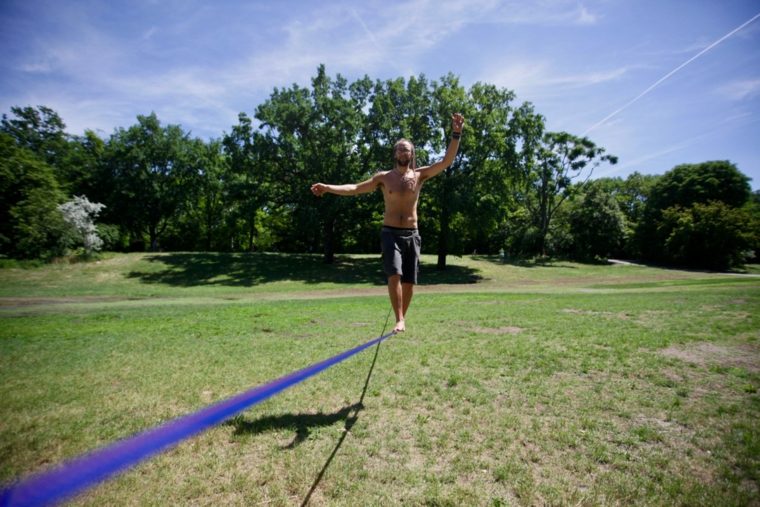
Some people prefer to start barefoot. While it may give you a better “feel” on the line, the difference is minimal. Shoes are much more comfortable on the line and less likely to slip (bare feet can get sweaty and slippery).
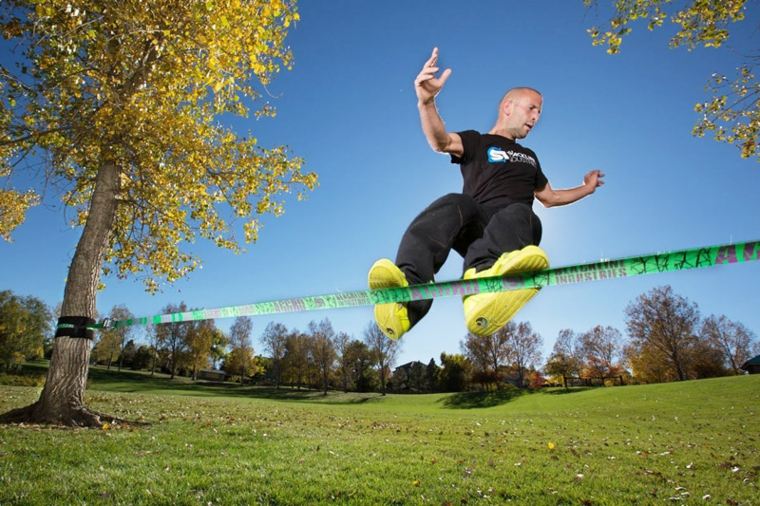
Once you’re on the line, resist the temptation to stand sideways with your feet at a 90-degree angle to the line. This is a more advanced stance and a harder way to start. Keep both feet pointing down the slackline.
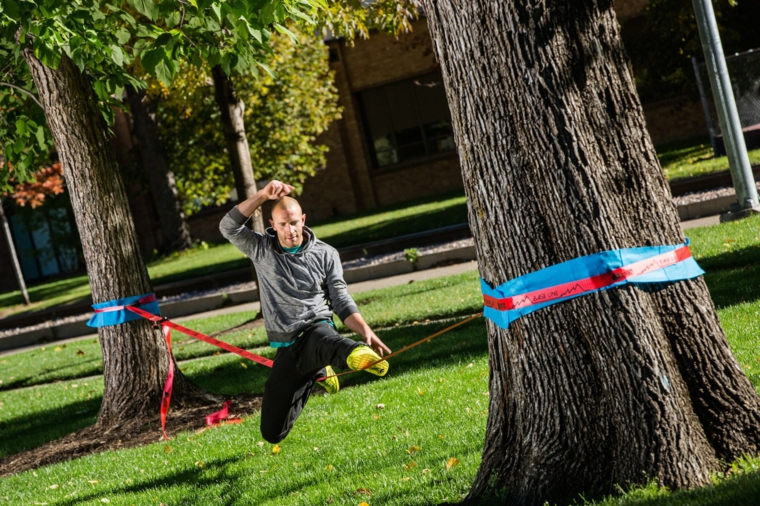
Once you’re on the line, find a fixed point directly in front of you to focus your eyes on. The tendency for most people is to look down at their feet. You’ll find it easier to maintain your balance when you focus on a fixed point rather than your shaky feet.
